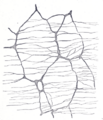Enteric nervous system
The enteric nervous system (ENS) is a subdivision of the Peripheral Nervous System, that directly controls the gastrointestinal system. It is capable of autonomous functions such as the coordination of reflexes, although it receives considerable innervation from the autonomic nervous system and thus is often considered a part of it. Its study is the focus of neurogastroenterology. It has as many as one billion neurons, one hundredth of the number of neurons in the brain, and considerably more than the number of neurons in the spinal cord. The enteric nervous system is embedded in the lining of the gastrointestinal system.
Layers
The neurons of the ENS are collected into two types of ganglia: myenteric (Auerbach's) and submucosal (Meissner's) plexuses. Myenteric plexuses are located between the inner and outer layers of the muscularis externa, while submucosal plexuses are located in the submucosa.
Complexity
There are several reasons why the enteric nervous system may be regarded as a second brain. The enteric nervous system can operate autonomously. It normally communicates with the CNS through the parasympathetic (eg, via the vagus nerve) and sympathetic (eg, via the prevertebral ganglia) nervous systems. However, vertebrate studies show that when the vagus nerve is severed, the enteric nervous system continues to function.
The complexity of the enteric nervous system is another reason for its status as a second brain. In vertebrates the enteric nervous system includes efferent neurons, afferent neurons, and interneurons, all of which make the enteric nervous system capable of carrying reflexes in the absence of CNS input. The sensory neurons report on mechanical and chemical conditions. Through intestinal muscles, the motor neurons control peristalsis and churning of intestinal contents. Other neurons control the secretion of enzymes. The enteric nervous system also makes use of the same neurotransmitters as the CNS, such as acetylcholine, dopamine, and serotonin. The enteric nervous system has the capacity to alter its response depending on such factors as bulk and nutrient composition.
ReferencesISBN links support NWE through referral fees
- The Second Brain by Dr. Michael D. Gershon
- "The Enteric nervous system (ENS)" at anaesthetist.com
- Saffrey M (2004). Ageing of the enteric nervous system.. Mech Ageing Dev 125 (12): 899–906. Link
- Grundy D, Schemann M (2006). Enteric nervous system. Curr Opin Gastroenterol 22 (2): 102–10. Link
- Furness JB (2006) The Enteric Nervous System. Blackwell, Oxford, pp 274
External links
- Physiology at MCG 6/6ch2/s6ch2_29
Additional images
Template:Gastrointestinal physiology
Credits
New World Encyclopedia writers and editors rewrote and completed the Wikipedia article in accordance with New World Encyclopedia standards. This article abides by terms of the Creative Commons CC-by-sa 3.0 License (CC-by-sa), which may be used and disseminated with proper attribution. Credit is due under the terms of this license that can reference both the New World Encyclopedia contributors and the selfless volunteer contributors of the Wikimedia Foundation. To cite this article click here for a list of acceptable citing formats.The history of earlier contributions by wikipedians is accessible to researchers here:
The history of this article since it was imported to New World Encyclopedia:
Note: Some restrictions may apply to use of individual images which are separately licensed.

